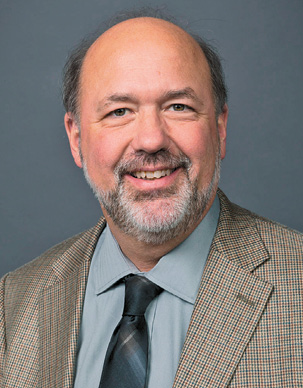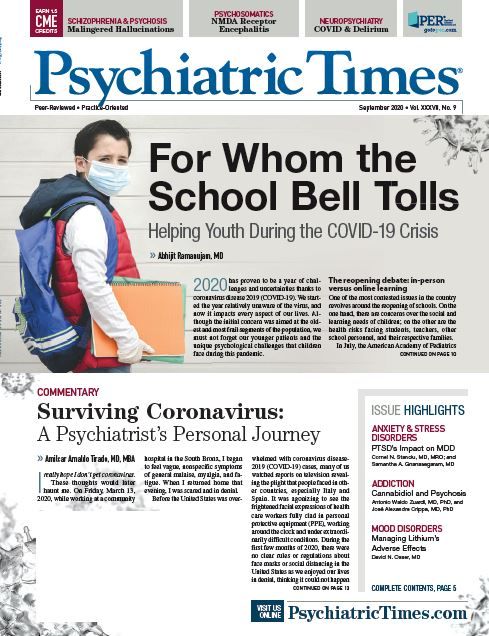Why are we Americans so divided and argumentative about the consistent public health recommendations from the experts who have spent their careers studying virology, medicine, and epidemiology to best protect ourselves from the possibility of a pandemic?
Publication
Article
Psychiatric Times
Pandemics Are Not Partisan
Author(s):
We have been here before. In fact, we have survived more challenging times. The truth serves as the foundational first brick of the edifice of knowledge and problem-solving.
John J. Miller, MD

From the Editor
As of this writing, we are well into August, and the COVID-19 pandemic continues to have a stranglehold on our country and the world. Hearing a lot about how this pandemic is starting to compete with the Great Influenza (H1N1) pandemic from 1918 through 1920, I decided to take a deep dive into learning about this widely referenced pandemic that is estimated to have killed 50 million people worldwide, and more than 600,000 people in the United States. I read with curiosity and amazement The Great Influenza, which chronicles in great detail the many subplots of this global pandemic that occurred while the world was also being brutalized by World War I.1 Remarkably, many of the same challenges we face in combatting COVID-19 existed during the Great Influenza: educating the public about the importance of social distancing; wearing masks; cancelling large gatherings of people; avoiding indoor crowds; quarantining individuals exposed to the virus; the trial and error of potential treatments; and most importantly, tirelessly working to create an effective vaccine.
As of today (August 18, 2020), 171,343 deaths in the United States hve been attributed to COVID-19. Unlike the Great Influenza, which basically ended 100 years ago, we really do not know how far we are into the COVID-19 pandemic.2 Fortunately, we have top-notch health care providers, scientists, epidemiologists, computer models, and worldwide information integration that collectively give us a huge advantage over the resources available during the Great Influenza. Significantly, we as a world community have had 100 years to research and understand the Great Influenza, which provides a wealth of guidance as to how to best control and ultimately defeat COVID-19.
I was intrigued by John M. Barry’s conclusion in The Great Influenza1:
“Those in authority must retain the public’s trust. The way to do that is to distort nothing, to put the best face on nothing, to try to manipulate no one. Lincoln said that first, and best. A leader must make whatever horror exists concrete. Only then will people be able to break it apart.”
This invitation to embrace the truth of what is serves as the foundational first brick of the edifice of knowledge and problem-solving. To be fair, the “truth of what is” is actually only a hypothesis, not objective truth. Any competent scientist will agree with this characterization. In science, we formulate a hypothesis based on observations and, through continued exploration and experimentation, each hypothesis is sculpted to a more sophisticated and refined hypothesis or is discarded. The integrity and confidence in the scientific process results from the countless scientists throughout the world and throughout the millennia that continue to challenge and refine our current hypotheses.
It is likely not a coincidence that 2 of the countries that aggressively implemented the lessons from the Great Influenza, New Zealand and South Korea, have had among the best viral containment and lowest numbers of death per capita.3,4 Ideally, science and its ever-evolving hypotheses should remain objective and nonpartisan. In the United States, this has become challenging, as we find ourselves in an extremely partisan political environment with an important presidential election rapidly approaching. As psychiatrists, physicians, and health care providers, let us remember our oath to “do no harm,” and aggressively educate our patients and our nation to modify basic behaviors consistent with the recommendations of the Centers for Disease Control, the Surgeon General, the National Institutes of Health, infectious disease experts, renowned epidemiologists, and current hypotheses about managing a pandemic that have been sculpted from the pain and suffering of past pandemics.
An important question to investigate is why are we Americans so divided and argumentative about the consistent public health recommendations from the experts who have spent their careers studying virology, medicine, and epidemiology to best protect ourselves from the possibility of a pandemic such as the one we are facing? There has always been a subset of the American population that opposes accepted recommended norms: anti-vaccines, no blood transfusions, no Western medical treatment, no need for seatbelts, intolerance for anyone’s views that differ, and no need for government, to list a few. Arguably, discussions that stem from these disagreements ultimately create a more open and sophisticated society and validate the liberty and freedom that the First Amendment fosters. But, in my opinion, the current divisions in America that readily dismiss science, medicine, and the lessons learned from other countries and history have crossed the red line into misinformation and self-righteousness that ultimately increases our illness, pain, suffering, and death. Is the rebelliousness that led to our independence as a nation sewn so deep into the fabric of our culture that it surfaces with any opportunity—regardless of the consequences? What is it about American culture that has led us down a lonelier road than the path taken by so many other countries that are more effectively managing the COVID-19 pandemic? I do not know.
I went back and read my May editorial about COVID-19, curious to see where we were, where we have been, and where we are.5 On April 8th there were more than 400,000 cases of COVID-19 and more than 14,000 deaths in the United States; today (August 18, 2020) there are more than 5,400,000 cases of COVID-19 and more than 171,000 deaths.2 I expressed my concern about the misinformation and lack of scientific expert inclusion in policy development around the country—those concerns have intensified. I shared my opinion that our response to the pandemic was fragmented and disorganized, with no united national leadership and database to aggressively track and manage a ruthless virus that did not respect state, county, or city boundaries—we remain fragmented and disorganized.
Last week my wife and my son were tested for COVID-19, and we were told that they should receive their results in 10 days—not only is that unacceptable, it is not an isolated case. To track and manage this virus, we need a rapid turnaround in test results—hours and not days. The scientist in me is greatly saddened by these facts, realizing we could be doing so much better.
We have much to learn about COVID-19, as is the case with any novel virus, pathogen, or disease. However, we have learned a great deal in less than a year of coexisting with this ruthless virus. The complete COVID-19 RNA genome has been sequenced, and there are documented mutations. The daily medical peer-reviewed published literature consistently includes a wide-ranging menu of information across every specialty in any way related to the virus and associated pandemic. We are still learning about how the virus is transmitted—which we now know is quite different depending on the length of time since a person becomes infected, and how symptomatic they are. We still do not know how long antibodies created by viral exposure will render immunity. I am appreciative of the global open-access articles that become available every day from researchers in all specialty fields. The pharmaceutical industries are working aggressively and tirelessly to develop a safe and effective vaccine, and manufacturing facilities around the world are ready to join forces for large scale production once an effective vaccine is created.
For us in psychiatry, there is currently a well-documented increase in anxiety, depression, trauma-related symptoms, substance abuse, and suicidality.6,7 Risk factors include infection by COVID-19, serious illness or death of a loved one infected by COVID-19, loneliness, financial distress, job loss, social isolation, and lingering medical/psychiatric symptoms after recovery from the acute COVID-19 infection.
This issue of Psychiatric Times® contains an article on the neuropsychiatric complications by Elliott Martin, MD, who discusses an increase in cases of refractory delirium and persistent encephalopathy at his hospital. A current publication by Li and Wang8 looked at the prevalence of psychiatric disorders and loneliness in the United Kingdom during the COVID-19 pandemic. Of the 15,530 respondents, 29% reported a psychiatric disorder, and 36% reported feeling lonely sometimes or often. Not surprisingly, they also determined, “Having a job and living with a partner are both significant protective factors for general psychiatric disorders and loneliness.”
We have no idea how the next 12 months will transpire. Will there be a second wave of COVID-19 as the Northern Hemisphere moves into the fall and winter months, and the influenza virus joins in the fray? Has the COVID-19 virus mutated during its travels in the Southern Hemisphere creating a more virulent and/or aggressive virus? When will an FDA-approved effective vaccine become available? How can we enhance trust in science so a COVID-19 vaccine will be welcomed with open arms, so that we can quickly achieve herd immunity? Currently, one-third of people in the United States are saying they will not get vaccinated. Will we develop effective treatments for the seriously ill?
There are also the collateral issues that can add to individual and societal stress, increasing the risk of psychiatric symptoms, substance abuse, hopelessness, fear, and loneliness. These include continued social isolation and the merry-go-round of opening—closing—reopening—reclosing of cities and towns as COVID-19 quiets down and then surges in unpredictable manners. Additionally, the struggle continues with economic uncertainty; unemployment; financial distress; childcare; online versus in-classroom education; and relationship stress.
We have been here before. In fact, we have survived more challenging times. Our United States prevails and excels when we are, in fact, united—not divided. So as we find ourselves in the middle of a pandemic, and all of its associated chaos and confusion, let us once again find our common ground and shared strength and unite as a country to show this pandemic—who we are, and how we rise above our partisan differences to defeat COVID-19—and be stronger for it. After all, the world is watching.
Dr Miller is medical director, Brain Health, Exeter, NH; editor in chief, Psychiatric Times®; staff psychiatrist, Seacoast Mental Health Center, Exeter, NH; consulting psychiatrist, Exeter Hospital, Exeter, NH; consulting psychiatrist, Insight Meditation Society, Barre, MA.
References
1. Barry JM. The Great Influenza: The Story of the Deadliest Pandemic in History. New York, NY: Penguin Books; 2004.
2. Johns Hopkins University School of Medicine. COVID-19 in the USA. Accessed August 18, 2020. www.coronavirus.jhu.edu
3. Baker MG, Wilson N, Anglemyer A. Successful Elimination of Covid-19 Transmission in New Zealand. N Engl J Med. 2020 Aug 7 [Epub aead of print]. Accessed August 19, 2020. https://www.nejm.org/doi/full/10.1056/NEJMc2025203.
4. Kim J, An JA, Min P, et al. How South Korea Responded to the Covid-19 Outbreak in Daegu. NEJM Catal. 2020;1(4). Accessed August 19, 2020. https://catalyst.nejm.org/doi/full/10.1056/CAT.20.0159.
5. Miller JJ. COVID-19: The Long, Slow Recovery. Psychiatric Times. 2020;37(5):6,8.
6. Troyer EA, Kohn JN, Honga S. Are we facing a crashing wave of neuropsychiatric sequelae of COVID-19? Neuropsychiatric symptoms and potential immunologic mechanisms. Brain Behav Immun. 2020;87:34-39.
7. Ornell F, Moura HF, Scherer JN, et al. The COVID-19 pandemic and its impact on substance use: Implications for prevention and treatment. Psychiatry Res. 2020;289:113096.
8. Li LZ, Wang S. Prevalence and predictors of general psychiatric disorders and loneliness during COVID-19 in the United Kingdom. Psychiatry Res. 2020;291:113267. ❒






